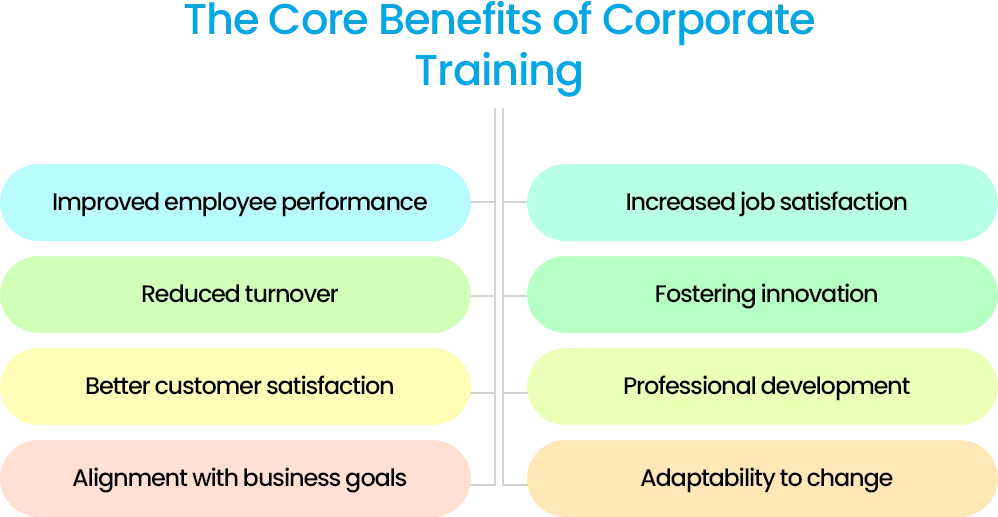Your employees might not feel confident in their roles because they aren’t getting the training they need. This lack of development leads to poor performance, decreased morale, and higher turnover. Worse, it could be costing your company money. The solution? A well-designed corporate training program that meets your team’s needs and boosts your bottom line.
Corporate employee training is no longer a “nice to have”—it’s critical for staying competitive. In 2024, companies that prioritize upskilling and remote learning will outperform those that don’t. Let’s explore how to create training that empowers employees and drives business success.
What is Corporate Training?
Corporate training is the process of educating employees to improve their skills and performance in the workplace. This type of training is good for running your business smoothly because it gives your staff the skills they require to excel in their positions. It can help employees progress professionally and personally, and contribute to the success of the company.
Corporate learning may cover a broad range of subjects, such as technical and regulatory competencies as well as soft skills like leadership development and communication. Over the years, workforce learning has evolved from traditional classroom settings to more interactive, technologically advanced methods.
These days, businesses offer flexible, interesting training using virtual reality, AI-powered platforms, and online learning or e-learning. These modern methods help businesses stay competitive and meet the needs of today’s workforce.
Businesswire report suggests that the Corporate E-Learning market is expected to reach $49.87 billion by 2026.
Many key stakeholders play a crucial role in the development and implementation of corporate training programs. These consist of HR, L&D teams, managers, and employees.
Human resources departments are responsible for the analysis of training needs and the development of training programs. The designing and execution of training programs is the area of expertise for learning and development teams. It is the responsibility of managers to identify team members who need training and to ensure that they enroll in relevant training programs. Employees are the primary beneficiaries of company training. They benefit from increased skills, knowledge, and career opportunities.
The Core Benefits of Corporate Training

1. Improved Employee Performance
Corporate team training equips employees with the skills they need to flourish in their positions, which improves productivity and overall performance.
2. Increased Job Satisfaction
Employees feel valued and motivated when they receive training which leads to higher job satisfaction and morale.
3. Reduced turnover
Employee engagement and loyalty are increased through training, which lowers loss and related expenses.
4. Fostering Innovation
Training boosts innovation within the organization by promoting creativity and problem-solving skills.
5. Better Customer Satisfaction
Well-trained employees deliver better service, which directly impacts customer satisfaction and business success.
6. Professional Development
Workplace training provides opportunities for growth, helping employees advance in their careers and become future leaders.
7. Alignment with Business Goals
Effective training ensures that employees’ development aligns with company objectives, enhancing overall organizational performance.
8. Adaptability to Change
Employees who engage in continuous development are more prepared to adjust to emerging technologies and changing consumer needs.
Businesses with extensive corporate training programs earn 218% more per employee than those without formal training programs.
Types of Corporate Training

1. Hard Skills Training
Focuses on technical skills such as Data Science, AI & Data Analytics, and industry-specific expertise that employees need to perform their jobs.
2. Corporate Soft Skills Training
This type of training develops communication, leadership, problem-solving, and emotional intelligence among employees which helps them work better with others.
3. Corporate Compliance Training
Compliance training makes sure that employees understand legal regulations, workplace ethics, and industry standards. It reduces risk for the company.
4. Employee Onboarding Training and Orientation
Introduces new hires to company policies, culture, and role expectations, helping them integrate quickly.
5. Diversity, Equity, and Inclusion (DEI) Training
Fosters a more inclusive workplace by addressing unconscious bias and promoting equity.
6. Corporate Leadership Training
Prepares employees for leadership roles by developing management and decision-making skills.
7. Health and Safety Training
Teaches employees about workplace safety, mental health awareness, and emergency procedures.
8. Product-Specific Training
Educates employees, especially sales teams, about the company’s products to improve customer service and performance.
9. Customized Training
Tailors programs to meet the specific challenges and goals of a business, ensuring relevance and impact.
10. Remote and Hybrid Training
Adapts training methods for employees working in remote or hybrid environments.
11. AI-Based Training and Adaptive Learning
Artificial intelligence is used in AI-based training and adaptive learning to improve training efficacy by personalizing learning routes.
12. Time Management Training
Improves prioritization, goal-setting, and delegation skills that help employees work efficiently and avoid burnout.
13. Cybersecurity Training
In this type of training, the companies educate employees on data protection, phishing awareness, and network security to safeguard company assets.
14. Industry Certification Programs
These programs ensure employees adhere to current standards and best practices while preparing them for industry-specific certifications.
15. Business Skills Training
Improves cooperation, leadership, communication, and negotiating abilities to help employees succeed in every type of workplace.
The Evolution of Corporate Training Methods
Corporate education programs have changed greatly from traditional classroom environments to more interactive, technologically advanced methods. Early training was mostly conducted through in-person, instructor-led training sessions, which were efficient but had limitations and were not successful.
E-learning emerged with the development of technology, which offered employees online courses they could do at their own pace. Due to this shift, blended learning was created, which offers the best of both worlds by combining online and in-person training.
More modern methods like gamification, microlearning, and mobile learning are now in demand. Employee engagement is maintained through brief, targeted training that is given on smartphones or tablets and accommodates their hectic schedules. AI-powered learning platforms now personalize training paths, while immersive technologies like Virtual Reality (VR) and Augmented Reality (AR) create hands-on experiences that bring training to life. These advancements ensure company training is more accessible, engaging, and effective.
Key Trends in Corporate Training for 2024
Corporate training is always changing, and in 2024, customization and innovation will be key components. AI and machine learning are a major factor in the customization of training materials, ensuring employees receive the precise training they require to advance. You’ll also see a focus on reskilling and upskilling to prepare teams for future roles, so they’re always ready for what’s next.
Diversity and inclusion training is moving beyond just ticking a box—it’s about real culture change. With more people working remotely, training for hybrid and remote teams is key. Companies are also using data-driven programs to make sure training is effective, and there’s a growing emphasis on mental health and sustainability, ensuring employees’ well-being and eco-friendly practices.
According to a McKinsey survey, a significant majority of 87% of executives believe that reskilling and upskilling their workforce is critical to their organization’s future success.
How to Build an Effective Corporate Training Program

Step 1. Assess Training Needs: The first thing you should do is use a skill gap analysis to detect any skill gaps. Try to understand where your team is lacking and what skills are most valuable for your business.
Step 2. Set Measurable Learning Goals: You also need to define clear objectives for the program. Make sure these goals are well aligned with your company’s overall business goals and growth plans.
Step 3. Choose the Right Training Methods: After setting the goals, select a mix of training formats that work for your team. It might resemble e-learning, a regular classroom, or a combination of the two.
Step 4. Customize Training Content: Next, you can create a tailored program that will reflect your company’s culture and employee demographics. Try to make it relevant and relatable for maximum engagement.
Step 5. Implement the Right Technology: Think about choosing a Learning Management System (LMS) that fits your needs. Make sure that it’s easy to use and also supports various training formats.
Step 6. Evaluate Program Success: You can use key performance indicators (KPIs) and employee feedback to measure the program’s success. Maintain long-term success by continually improving your programs on the basis of the outcomes.
Measuring the ROI of Corporate Training
Include both tangible and intangible results, when you calculate the return on investment (ROI) of training. Start by tracking key performance metrics like productivity, efficiency, and overall business impact. You should look at job satisfaction and employee retention rates to see whether the training is keeping your team motivated and devoted.
Connect training programs to broad corporate goals like increased sales or satisfied customers to show their immediate impact. Lastly, perform a cost-benefit analysis to ensure that your training investment is well-aligned with the long-term benefits for your business.
Best Practices for a Successful Corporate Training

- Conduct a Skills Gap Analysis: Do a skills gap analysis to pinpoint where your team could use a boost.
- Assess Training Needs: Make sure training addresses real needs, so you’re using resources effectively.
- Blended Learning Approach: Combine face-to-face and online methods to cater to different learning preferences.
- Create Engaging Training Materials: Ensure content is clear and aligned with learning objectives to drive better results.
- Provide Regular Feedback: Give regular, constructive feedback to your team. This can improve their job performance and boost their confidence.
- Use Microlearning: Break down training content into smaller, bite-sized lessons to help your team retain information better and stay motivated.
- Align with Organizational Goals: Tie employee development to company objectives. This will help you achieve your goals and make your team feel more connected to the company.
- Foster a Continuous Learning Culture: Promote continuous learning by giving your team access to industry experts and new ideas.
- Gain Leadership Buy-In: Ensure executives support the training program to increase its impact and success.
- Encourage Collaboration and Feedback: Build a feedback loop to continuously improve training effectiveness.
Corporate Training Case Study
A leading medical device company Cochlear Implants was faced with slow, inefficient sales reporting that made it difficult to get important data and make decisions. They wanted to give their sales team the tools they needed to independently generate custom reports and gain access to insightful data to remain competitive. TechForce Academy partnered with them to give them a solution through specialized corporate sales training and continuous assistance.
- Customized Training:
- Assessed current tools and designed training specific to their needs.
- Focused on report creation, data visualization, and automation techniques to save time.
- Post-Training Support:
- Provided one-on-one coaching and continuous feedback.
- Guided the team in creating their first set of reports to build confidence.
Results: The sales team experienced a 5x improvement in report creation speed, empowering them with increased autonomy and better sales insights. The tangible benefits resulted in considerable time savings and cost efficiency, while the intangible benefits encouraged a data-driven culture and enhanced team morale.
As a result of this change, they are now well-positioned to meet consumer demands and seize new opportunities.
Get in touch with us to upskill your employees and receive a number of benefits. At TechForce Academy, we offer tailored corporate professional development programs, cost-effective corporate training Solutions, and more!
Upskill Your Workforce with TechForce Academy: A Corporate Training Solution
Are your employees struggling to keep up with the latest tech trends such as AI or Business Skills? Upskilling can be a challenge in today’s fast-paced environment. This is where TechForce Academy can be a great help.
Your workforce can be equipped with practical, real-world skills tailored to your company’s goals. Our flexible and customizable training ensures that your team can learn without disrupting their work schedule, driving immediate value and long-term success.
Start Your Corporate Training Journey with TechForce Academy.Let’s discuss how to elevate your team’s performance! Book a consultation!
Conclusion: The Future of Corporate Training
Corporate training is no longer a luxury, it’s essential for staying competitive in 2024. Businesses can get greater employee performance, higher morale, and better alignment with organizational goals by investing in customized, engaging programs. Modern training methods, such as AI-powered platforms, blended learning, and microlearning, offer flexible and efficient solutions for today’s workforce.
To succeed, companies must assess skill gaps, set measurable goals, and foster a culture of continuous learning. Ready to empower your team and boost your bottom line?











